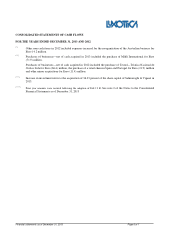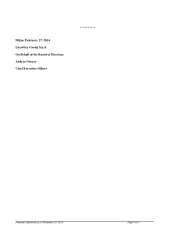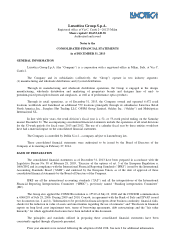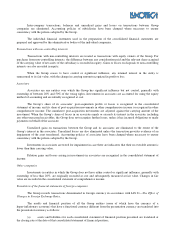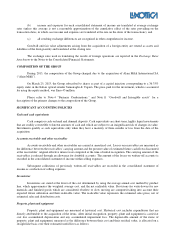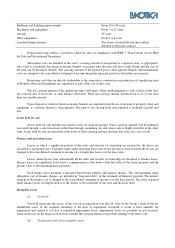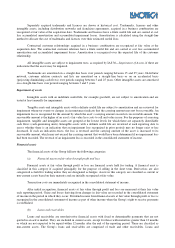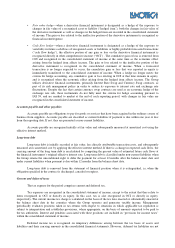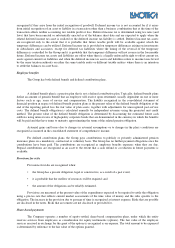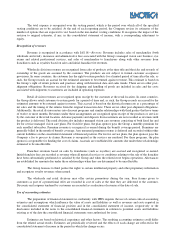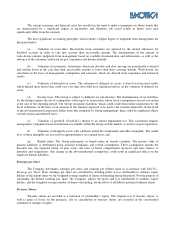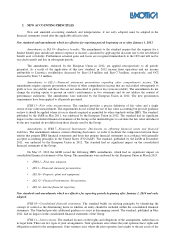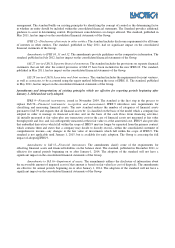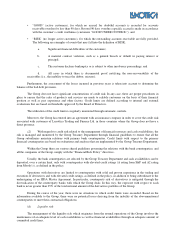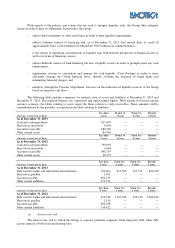LensCrafters 2013 Annual Report Download - page 104
Download and view the complete annual report
Please find page 104 of the 2013 LensCrafters annual report below. You can navigate through the pages in the report by either clicking on the pages listed below, or by using the keyword search tool below to find specific information within the annual report.
Separately acquired trademarks and licenses are shown at historical cost. Trademarks, licenses and other
intangible assets, including distribution networks and franchisee agreements, acquired in a business combination are
recognized at fair value at the acquisition date. Trademarks and licenses have a finite useful life and are carried at cost
less accumulated amortization and accumulated impairment losses. Amortization is calculated using the straight-line
method to allocate the cost of trademarks and licenses over their estimated useful lives.
Contractual customer relationships acquired in a business combination are recognized at fair value at the
acquisition date. The contractual customer relations have a finite useful life and are carried at cost less accumulated
amortization and accumulated impairment losses. Amortization is recognized over the expected life of the customer
relationship.
All intangible assets are subject to impairment tests, as required by IAS 36—Impairment of Assets, if there are
indications that the assets may be impaired.
Trademarks are amortized on a straight-line basis over periods ranging between 15 and 25 years. Distributor
network, customer relation contracts and lists are amortized on a straight-line basis or on an accelerated basis
(projecting diminishing cash flows) over periods ranging between 3 and 25 years. Other intangible assets are amortized
on a straight-line basis over periods ranging between 3 and 7 years.
Impairment of assets
Intangible assets with an indefinite useful life, for example goodwill, are not subject to amortization and are
tested at least annually for impairment.
Tangible assets and intangible assets with a definite useful life are subject to amortization and are reviewed for
impairment whenever events or changes in circumstances indicate that the carrying amount may not be recoverable. An
impairment loss is recognized for the amount by which the asset’s carrying amount exceeds its recoverable amount. The
recoverable amount is the higher of an asset’s fair value less costs to sell and value in use. For the purposes of assessing
impairment, tangible and intangible assets are grouped at the lowest levels for which there are separately identifiable
cash flows (cash-generating units). Intangible assets with a definite useful life are reviewed at each reporting date to
assess whether there is an indication that an impairment loss recognized in prior periods may no longer exist or has
decreased. If such an indication exists, the loss is reversed and the carrying amount of the asset is increased to its
recoverable amount, which may not exceed the carrying amount that would have been determined if no impairment loss
had been recorded. The reversal of an impairment loss is recorded in the consolidated statement of income.
Financial assets
The financial assets of the Group fall into the following categories:
(a) Financial assets at fair value through profit and loss
Financial assets at fair value through profit or loss are financial assets held for trading. A financial asset is
classified in this category if acquired principally for the purpose of selling in the short term. Derivatives are also
categorized as held for trading unless they are designated as hedges. Assets in this category are classified as current or
non-current assets based on their maturity and are initially recognized at fair value.
Transaction costs are immediately recognized in the consolidated statement of income.
After initial recognition, financial assets at fair value through profit and loss are measured at their fair value
each reporting period. Gains and losses deriving from changes in fair value are recorded in the consolidated statement
of income in the period in which they occur. Dividend income from financial assets at fair value through profit or loss is
recognized in the consolidated statement of income as part of other income when the Group’s right to receive payments
is established.
(b) Loans and receivables
Loans and receivables are non-derivative financial assets with fixed or determinable payments that are not
quoted in an active market. They are included in current assets, except for those with maturities greater than 12 months
or which are not expected to be repaid within 12 months after the end of the reporting period. These are classified as
non-current assets. The Group’s loans and receivables are comprised of trade and other receivables. Loans and




